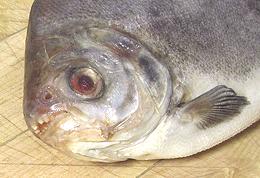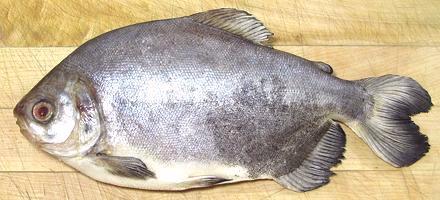
 [Butterfish (Asian Market - wrong); Piaractus mesopotamicus
(fb Pacu) | similar Colossoma macropomum
(fb Cachama)]
[Butterfish (Asian Market - wrong); Piaractus mesopotamicus
(fb Pacu) | similar Colossoma macropomum
(fb Cachama)]
Native to the rivers of South America, these fish are of the Piranha family (yes, they can bite), and related to Carp and Milkfish at the superorder level. The photo specimen was found in the frozen fish cases of a large Asian market here in Los Angeles, labeled "Butterfish", though it is entirely unrelated to the Butterfish family or to any other fish so called.
P.mesopotamicus can grow to 21 inches and 44 pounds, but the largest specimen I have purchased was 12-3/4 inches long and weighed 1 pound 12-3/4 ounces. C. macropomum looks a lot like P. mesopotamicus but has very wide gill covers and can get up to 42 inches and 88 pounds. Both species are farmed, as is Piaractus brachypomus also. All three are considered non-threatened (though threatening).
For more on Paranha Family.
.

There are stories of these fish mistaking the testicles of skinny dipping men for their normal food, biting off said danglies, with sometimes fatal results. Others say these stories are not true, but a large pacu certainly could do that (see teeth, photo at left).
The flesh of this fish is firm, medium flavored and pleasant. There is a small dark strip down the center under the skin which tastes just a bit oily, but not unpleasantly so. The flesh holds together well in all forms of cooking and can be cooked skin-on or skin-off. The belly, thin on most fish, is thick, stiff and fatty, as it is on a milkfish.
On the downside, there are scattered branching spines in the flesh, as in most other Carp related fish. There is no way to remove them, so they must be dealt with on the plate and in the mouth. While this is not a problem for most of the world, Americans are not accustomed to dealing with these, so are missing out on some very delicious fish.
Buying: One large Asian market here in Los Angeles had a good supply of these in the frozen fish cases, made up in trays of two fish each - but mislabeled "Butterfish". This was in mid 2011, but I haven't found any since.
Scales: This fish is completely covered with tiny but rather stiff scales that take a lot of energy to remove. Normal scraping won't work - the entire fish has to be shaved with the sharp edge of a strong prep knife, working vigorously and from various angles. This is about as hard to scale as fish come. On the other hand, if cooking a whole fish, you could probably cook it scales on and then peel off the skin after cooking.
Cleaning: This fish has a hard keel running from the head back to the anal fin, so you can't cut straight into the belly. There is also a hard ridge at the top from the head to the dorsal fin. Easiest is to cut off the head. Pull it straight forward and just about all the innards pull off with it. Split the belly on both sides of the keel back to the vent (just in front of the anal fin) with kitchen shears. If you need the fish head-on, knife cut on both sides of the keel from chin to vent and pull it out with long nose pliers, including the pelvic fins. This will give you easy access to the body cavity, which is large and filled with stiff fat deposits. Pull the gills with long nose pliers.
Fillet: This fish fillets very nicely and has an easy to follow bone structure. Cut along both sides of the anal fin and across the tail. From the front back, cut down to the backbone, than over the backbone at the tail and work forward to the body cavity. Cut the ribs from the backbone with kitchen shears and pull them from the fillet with long nose pliers. They are many and long, but pull out fairly easily, taking little flesh. There are scattered spines in the flesh, but they are too fragile to pull and stuck in hard.
Yield: A 1 pound 12-3/4 ounce fish yielded 13-1/2 ounces of fillet skin-on (47%) and 12-1/8 ounces skin-off (42%).
Skin: The skin has no strong or "off" flavor. Cooked it is a little gelatinous. Slowly heated as in steaming or baked the skin actually expands, so no cuts through it are needed. Pan fried, shrink is fairly severe, but the skin very soon blisters away from the flesh and the fillet can be gently patted down flat. For poaching it is best to use skinless fillet. The skin will curl the fillet into a roll upon hitting the poaching liquid, though it will then relax and the fillet can be flattened. Raw, the skin is very tough and can be removed cleanly and easily using the standard long knife Method.
Stock: The heads, bones and fins, simmered slowly for 40 minutes, make a light, nearly clear and very serviceable stock.
sf_pacuz 110513 - www.clovegarden.com